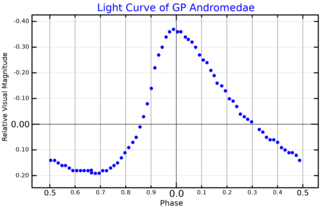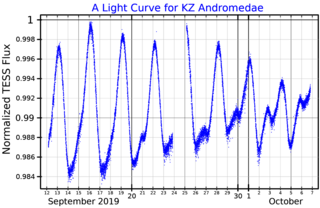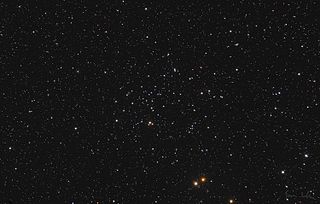Gliese 674(GJ 674) is a small red dwarf star with an exoplanetary companion in the southern constellation of Ara. It is too faint to be visible to the naked eye, having an apparent visual magnitude of 9.38 and an absolute magnitude of 11.09. The system is located at a distance of 14.8 light-years from the Sun based on parallax measurements, but is drifting closer with a radial velocity of −2.9 km/s. It is a candidate member of the 200 million year old Castor stream of co-moving stars.

Zeta Andromedae is a star system in the constellation Andromeda. It is approximately 189 light-years from Earth.

28 Andromedae is a Delta Scuti variable star in the constellation Andromeda. 28 Andromedae is the Flamsteed designation. It also bears the variable star name GN Andromedae. Its apparent magnitude is 5.214, varying by less than 0.1 magnitudes.

9 Aurigae is a star system in Auriga (constellation). It has an apparent magnitude of about 5, making it visible to the naked eye in many suburban skies. Parallax estimates made by the Hipparcos spacecraft put it at about 86 light-years from the solar system, although individual Gaia Data Release 3 parallaxes place all three components at 88 light years.
HD 166 or V439 Andromedae is a 6th magnitude star in the constellation Andromeda, approximately 45 light years away from Earth. It is a variable star of the BY Draconis type, varying between magnitudes 6.13 and 6.18 with a 6.23 days periodicity. It appears within one degree of the star Alpha Andromedae and is a member of the Hercules-Lyra association moving group. It also happens to be less than 2 degrees from right ascension 00h 00m.

OU Andromedae is a rotationally variable star in the constellation Andromeda. Varying between magnitudes 5.87 and 5.94, it has been classified as an FK Comae Berenices variable, but the classification is still uncertain. It has a spectral classification of G1IIIe, meaning that it is a giant star that shows emission lines in its spectrum. It is also likely in its horizontal branch phase of evolution.
HD 224801, also known as CG Andromedae, is an Alpha2 Canum Venaticorum variable star in the constellation Andromeda. Located approximately 188 parsecs (610 ly) away, the star varies between apparent magnitudes 6.32 and 6.42 over a period of approximately 3.74 days.

V1073 Scorpii is a variable star in the constellation Scorpius. It has a non-Greek Bayer designation of k Scorpii. The star has a blue-white hue and is visible to the naked eye with an apparent visual magnitude that fluctuates around +4.87. Parallax measurements yield a distance estimate of approximately 2,920 ly (896 pc) from the Sun, and it is drifting further away with a radial velocity of +7 km/s. It has an absolute magnitude of −6.8

Y Centauri or Y Cen is a semiregular variable star in the constellation of Centaurus.
GJ 3512 is a nearby star in the northern circumpolar constellation of Ursa Major. It is invisible to the naked eye but can be observed using a telescope, having an apparent visual magnitude of +15.05. The star is located at a distance of 31 light-years from the Sun based on parallax. It has a high proper motion, traversing the celestial sphere at the rate of 1.311″ yr−1. The measurement of the star's radial velocity is poorly constrained, but it appears to be drifting further away at a rate of ~8 km/s.
QV Andromedae is an Alpha2 Canum Venaticorum variable in the constellation Andromeda. Its maximum apparent visual magnitude is 6.6, so it can be seen by the naked eye under very favourable conditions. The brightness varies slightly following a periodic cycle of approximately 5.23 days.

LQ Andromedae is a variable star in the constellation Andromeda. Its maximum apparent visual magnitude is 6.5, placing it at the limit of the visibility to the naked eye. The brightness, however, drops down to 6.66 with a periodic cycle of roughly 7.44 hours.

GP Andromedae is a Delta Scuti variable star in the constellation Andromeda. It is a pulsating star, with its brightness varying with an amplitude of 0.55 magnitudes around a mean magnitude of 10.7.

GR Andromedae is a variable star in the constellation Andromeda. Its apparent visual magnitude varies between 6.87 and 6.95 in a cycle of 518.2 days. It is classified as an α2 Canum Venaticorum variable.

HN Andromedae is a variable star in the constellation Andromeda. Its apparent visual magnitude varies between 6.67 and 6.76 in a cycle of 69.51 days. It is classified as an α2 Canum Venaticorum variable.

KZ Andromedae is a double lined spectroscopic binary in the constellation Andromeda. Its apparent visual magnitude varies between 7.91 and 8.03 during a cycle slightly longer than 3 days.

LP Andromedae is a carbon star in the constellation Andromeda. It is also a Mira variable whose mean apparent visual magnitude is 15.12 and has pulsations with an amplitude of 1.50 magnitudes and a period of 614 days.

QX Andromedae is an eclipsing binary in the constellation Andromeda. It varies from a maximum apparent visual magnitude of 11.28 to a minimum of 11.50. Since it is impossible to specify the onset time of the eclipses, it is classified as a W Ursae Majoris variable star. It is also observed as an X-ray source and is a member of the open cluster NGC 752.
Gliese 49 is a star in the northern constellation of Cassiopeia. Visually, it is located 106 arcminutes north of the bright star γ Cassiopeiae. With an apparent visual magnitude of 9.56, it is not observable with the naked eye. It is located, based on the reduction of parallax data of Gaia, 32.1 light-years away from the Solar System. The star is drifting closer to the Sun with a radial velocity of −6 km/s.

GK Tauri is a young T Tauri-type pre-main sequence star in the constellation of Taurus about 421 light years away, belonging to the Taurus Molecular Cloud.














